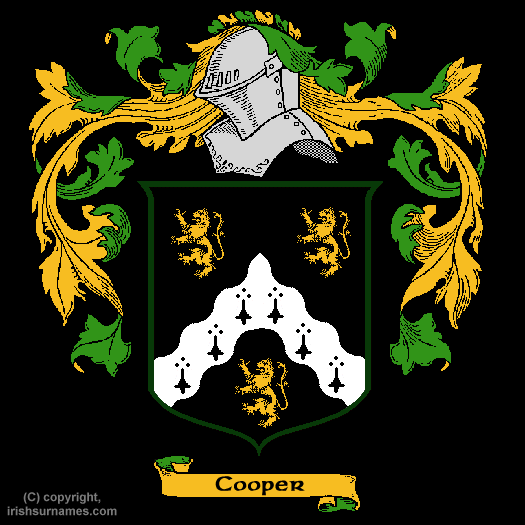Cooper Coat of Arms, Family Crest and Cooper Family History
Cooper Family History
The ancient origin of the name Cooper was found in the irishsurnames.com archives.
Surnames developed a wide number of variants over the centuries. Many different spelling variations of the same name can be traced back to a single original root. Also, when a bearer of a name emigrated from Ireland it was not uncommon that their original name would be incorrectly transcribed in the record books upon arrival at their new location. Some names have dozens of spelling variations. Some Surnames were also altered over the years based on how they sounded phonetically, by their sound, and depending on the prevailing political conditions it may have been advantageous to change a name from one language to another. This was especially so in Ireland where most Gaelic names were 'anglicized' at some stage.
Variants of the name Cooper include Couper, Cooperson, Copper and Cowper. This is an occupational name meaning 'the cooper', from a person who made their living as a barrel maker. This name is of Anglo-Saxon descent spreading to the Celtic countries of Ireland, Scotland and Wales in early times and is found in many mediaeval manuscripts throughout these countries. Examples of such are an Alan le Cupere, County Cambridgeshire, England, who was recorded in the 'Hundred Rolls' in the year 1273. A John Cupar held land in Aberdeen, Scotland, in the year 1281. A William Cooper and Hannah Mapies were married in Saint Georges Chapel, Mayfair in the year 1747. Names were recorded in these ancient documents to make it easier for the overlords to collect taxes and to keep records of the population at any given time. When the overlords acquired lands by either force or as gifts from their rulers, they created charters of ownership for themselves and their vassals.In Ireland this name and its variants were introduced into Ulster Province by settlers who arrived from England and Scotland, especially during the seventeenth century. During the 'Plantations of Ireland' in the sixteenth and seventeenth centuries Ireland was colonized by the English Crown with this period marking the end of Gaelic supremacy in Ireland. This period brought an influx of settlers into the country but, unlike the earlier Anglo-Norman invasion of the twelfth century that resulted in a full integration into Irish society of the new arrivals, the same never occurred with the Ulster Planters who maintained their own distinct identity.
Families of the name became prominent in County Sligo.The Cooper family crest (or coat of arms) came into existence many centuries ago. The process of creating these coats of arms began as early as the eleventh century although a form of Proto-Heraldry may have existed in some countries prior to this, including Ireland. The new more formalized art of Heraldry made it possible for families and even individual family members to have their very own family crest, coat of arms, including Cooper descendants.Meaning of Symbols & Colors on the Cooper Coat of Arms
| Ermine | Associated with the robes and crowns of Royal and Noble Personages | |
| Or/Yellow/Gold | Represents Generosity. | |
| Sable/Black | Denotes Constancy and sometimes Grief. | |
| The Chevron | Denotes Protection. Often granted as a reward to one who has achieved some Notable Enterprise | |
| Wavy | Often representing water | |
| The Lion | Emblem of Deathless Courage |
Wonderful COOPER Gifts For Every Occasion
Show Off Your Heritage With Our Range OfCooper Family Crest Gifts
For a Limited Time We Are Offering Free Delivery.




















